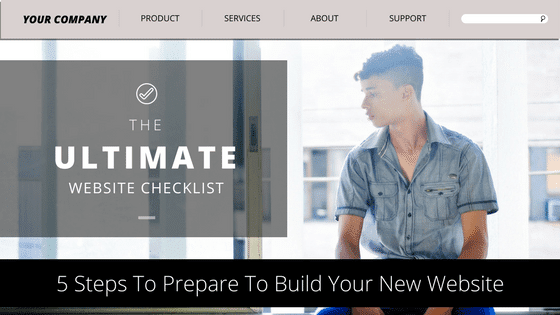Having a website is a huge part of a small business’ digital marketing strategy. The website serves as a hub for all the content, the best place for customers to learn about your product, and the most direct way for your audience to communicate with you.
It’s important to understand how to make your website as effective as possible. Sometimes, the best way to do that is to study what others are doing wrong. In that way, you learn exactly what mistakes not to make.
Contents
Most Small Business Owners Understand The Value Of A Website
There aren’t many small business owners that don’t believe a website is important to their business. Most people recognize a website as a requirement to build credibility in the modern business world. Consumers will check there first to discover whether your company is credible.
Despite this fact, many small businesses don’t have websites, primarily because they believe a site is outside their budget. Technically, this is the first mistake that should be on this list, but we’ll be focused on the mistakes often made when the website is built. But know that a website is likely more affordable than you think, and we’d be happy to discuss creating yours with you.
These Mistakes Can Kill Your Small Business’ Website Traffic
Here’s the kicker: if you’ve taken the time and made the investment towards having a website for your small business, you want it to work right. It has to get traffic, create engagement, and convert visitors to leads. Otherwise, it’s all a waste.
The mistakes we’re going to outline below will undermine all of the work you put into your small business’ website. They are guaranteed to have a negative effect on engagement. That means your bounce rate – the number of people who jump off your website before spending any real time on it – will go up. When visitors bounce, they don’t become leads. A high bounce rate is also going to hurt your SEO, which means you’ll see fewer visitors long-term.
Most Small Businesses Can Avoid These Website Mistakes
The good news is that most of these mistakes are easy to avoid right at the beginning. When your small business first has its website build, all of these should be standard practice. That is, as long as your website developer knows what to do. Here they are (in no particular order).
Your Website Isn’t Mobile Friendly
In 2012, Google made a huge shift. Known as Mobilegeddon, the search giant decided to weigh a website’s ability to be viewed on mobile as a part of its search ranking. This officially made mobile design a cornerstone, especially for small business.
If your small business’ website still isn’t mobile friendly, you can guarantee that you won’t get the return from it that you ought to. Be sure your site is responsive, built with mobile use in mind. With 56% of internet access coming from mobile devices, it’s the most likely way people will find your site.
Your Small Business Website Isn’t Intuitive
Ever visited a website that you couldn’t navigate? It’s frustrating as can be, and I’d bet you left the site quickly. You see, a user interface is everything. If a user can’t make your website work, they’ll head to your competitor quickly, and you’ll be out the client.
There needs to be a logical flow to your small business’ website. Your visitors should be able to find the information they want quickly and without any trouble. A clear informational layout, obvious and intuitive navigation, clear color contrast, and crisp text are all key to a site that’s easy to use.
Your Website Has Missing Or Incomplete Information
One of the primary reasons a person visits a website is for information. Usually, they want to know about your company, especially the details they might not get through your regular marketing efforts. Things like your mission statement, your contact information, and other less obvious information are all often sought out by your site visitors.
Make sure you’re not tempted to skip these pieces of information to rush to a site launch. Leaving behind 404 pages, “under construction” placeholders, and other forms of missing content will hurt your conversion rates. Moreover, assure that the information is complete and up-to-date. If your clients try to call you only to find out it’s an old number, you’ll lose those opportunities too.
You Don’t Clearly Present Your Product Or Service
You’d be surprised how often you come across small business websites that don’t clearly demonstrate what the company sells. When your visitors go to your website, they want to know what you do. However, service descriptions are often far too ambiguous to help.
Make sure you clearly outline what your company offers. Inform your visitors in bits, allowing them to dig deeper to find out more information with ease. A clear path to your products and services, as well as an easy way to purchase them from you, are essential to a great site.
You Keep Your Visitors In The Dark About Who You Are
As a small business, one of the greatest advantages you can give yourself is a direct relationship with your audience. Despite that, many small business websites don’t include information about the company’s staff, or at least it’s front-line or executive team. It’s a fatal mistake.
Include a section of content that introduces your website visitors to your small business’ staff. Pick and choose who you want to include, from the executive team to the front lines, based on who your clients should be building the strongest relationships with. Include pictures of their smiling faces where it makes sense.
You Offer No Incentive To Stay In Contact With Your Company
If the purpose of your website is to gain leads, you need visitors to offer up their contact information. While an inconsistent email newsletter form may feel like a great way to handle that, there’s no way you’ll ever use that to gather qualified leads. After all, what incentive are you offering for them to exchange more than an email address?
Offer strong lead magnets to your visitors. The higher the perceived value, the more information they’ll be willing to exchange. When you can solve a problem for them with a free download, they’ll be glad to turn over their name, contact number, and company name along with their email address. That means you have someone real to connect with.
Your Website Doesn’t Feature Interesting Content
One of the key factors of SEO is website engagement. For your small business, SEO is going to provide the most effective means of exposure to the audience outside your personal network. But how can you build positive engagement when, like so many other small business websites, you aren’t producing content for your market?
Plan and produce content on your site that your audience will find interesting. Put together a strategy that will tap your small business’ expertise to inform and engage your website visitors. Create buzz by distributing the right content through the right social channels at the right time to get your followers to tap in and share it.
You Don’t Tell Your Visitors What To Do Next
Your site is live. Your audience has found their way to it, diving into interesting content that your team has produced. But now what? They’ve reached the end of that content and there’s no indicator of where to go or what to do next. They’re going to leave.
Every point of contact on your website for your target audience needs to have a call to action. Give instructions to your visitors on how to engage with your small business next. This is not only a great place to include your lead magnet, but also an opportunity to direct them to more content relevant to their interests or aim them at a product that might be a fit. When they know what to do next, they’ll stick around longer, giving you a better shot at the sale.
Visitors Can’t Share Your Content Easily
Would you believe that a large portion of the population doesn’t know where the address bar on their browser is? It’s rather incredible, in that regard, that so many small business websites rely on their customers to find the URL there when they want to share great content. It’s a failing proposition.
Include share buttons on every piece of content you create. Your website visitors should be able to share your small business’ content with a quick click of a mouse. Share links are super easy to add, too. Services like AddThis, ShareThis, and Buffer, as well as many platform specific options, make software that’s simple to integrate into any website.
A Great Small Business Website Never Misses The Essentials
These mistakes are easy to plan around and simple to avoid. All your small business needs is a plan when you build your website. Taking the essentials into play, your website will provide a return on your investment that exceeds your expectations.





